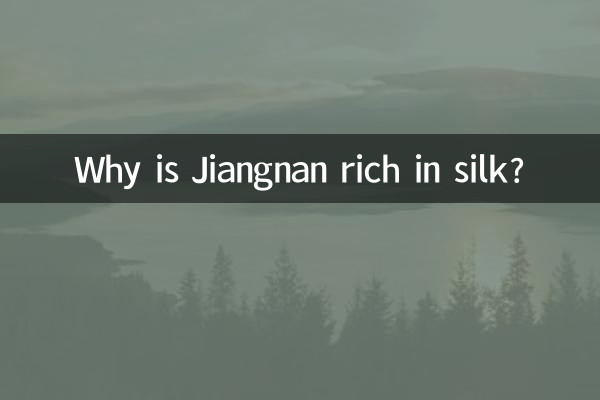Why is Jiangnan rich in silk?
Silk, as one of the symbols of traditional Chinese culture, has been a representative industry in the Jiangnan region since ancient times. The Jiangnan region (mainly including Jiangsu, Zhejiang, Shanghai and other places) has become an important base for silk production in China and even the world due to its unique geographical environment, climatic conditions and historical accumulation. This article will combine structured data to analyze the reasons why Jiangnan is rich in silk from aspects such as natural conditions, historical origins, technological inheritance and industrial distribution.
1. Superior natural conditions

The climate and soil conditions in the Jiangnan region are very suitable for mulberry planting and sericulture. The following is the climate comparison data between Jiangnan and other regions:
| area | average annual temperature | annual precipitation | Suitable mulberry growth index |
|---|---|---|---|
| Jiangnan | 15-18℃ | 1000-1400mm | ★★★★★ |
| North China | 10-12℃ | 500-800mm | ★★★☆☆ |
| southwest | 14-16℃ | 800-1200mm | ★★★★☆ |
As can be seen from the table, the warm and humid climate in the Jiangnan region provides an ideal growth environment for mulberry trees, and mulberry leaves are the only food source for silkworms. Therefore, the Jiangnan region has unique basic conditions for silk production.
2. Deep historical origins
The history of silk production in the Jiangnan region can be traced back to the late Neolithic Age, more than 5,000 years ago. The following are important historical nodes in the development of Jiangnan silk:
| period | Development characteristics | Representative sites/records |
|---|---|---|
| Liangzhu Culture | Primitive textile tools emerge | Liangzhu Site in Yuhang, Zhejiang |
| Spring and Autumn Period and Warring States Period | Silk technology is initially mature | According to "Shang Shu Yu Gong" |
| Tang and Song Dynasties | Become a national silk center | Suzhou and Hangzhou set up weaving bureaus |
| Ming and Qing Dynasties | Globalization of silk trade | Maritime Silk Road Hub |
These historical accumulations have enabled the Jiangnan region to accumulate rich silk production experience and technological inheritance, forming a complete industrial system.
3. Technology inheritance and innovation
The Jiangnan region has always been in a leading position in silk production technology. The following are the main technical advantages of Jiangnan silk:
| Technical aspects | traditional craft | modern innovation |
|---|---|---|
| Silkworm breeding | High-quality varieties such as Hu silkworm and Su silkworm | genetic improvement technology |
| Reeling process | Hand reeling | Automatic reeling machine |
| weaving technology | Traditional crafts such as Yun Brocade and Song Brocade | Digital jacquard technology |
| Printing and dyeing process | vegetable dyes | Environmentally friendly printing and dyeing technology |
The inheritance and innovation of these technologies enable Jiangnan Silk to continuously improve production efficiency and product quality while maintaining its traditional characteristics.
4. Industrial agglomeration effect
A complete silk industry cluster has formed in the Jiangnan region. The following are the main production areas and their characteristics:
| area | Main products | Annual output value (100 million yuan) |
|---|---|---|
| suzhou | Song brocade, tapestry | 120 |
| Hangzhou | silk clothing | 180 |
| Huzhou | silk quilt | 90 |
| Jiaxing | silk fabric | 75 |
This industrial agglomeration not only reduces production costs, but also promotes technological innovation and brand building, making Jiangnan Silk highly competitive in both domestic and foreign markets.
5. Cultural value and brand effect
Jiangnan silk is not only a commodity, but also a cultural symbol. In 2009, China's sericulture and silk weaving skills were included in the UNESCO Representative List of Intangible Cultural Heritage of Humanity. The silk culture in the Jiangnan region is reflected in:
1. Traditional festivals: such as Hangzhou's "Silk Culture Festival", Suzhou's "Zhizaofu Culture Week", etc.;
2. Museum construction: China Silk Museum (Hangzhou), Suzhou Silk Museum, etc.;
3. Cultural and creative products: silk books, silk stamps, silk artworks, etc.
This cultural value is transformed into brand effect, further enhancing the market value of Jiangnan Silk.
Conclusion
The abundance of silk in the Jiangnan region is the result of multiple factors such as natural conditions, historical accumulation, technological innovation, industrial agglomeration and cultural inheritance. From silkworm breeding to silk weaving, from technological innovation to cultural inheritance, the Jiangnan region has formed a complete silk industry ecology. In the future, with the advancement of science and technology and the development of cultural and creative industries, Jiangnan Silk will continue to maintain its unique charm and become an important carrier for Chinese traditional culture to the world.

check the details

check the details